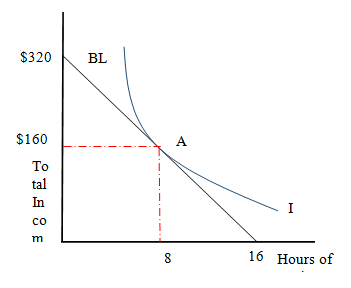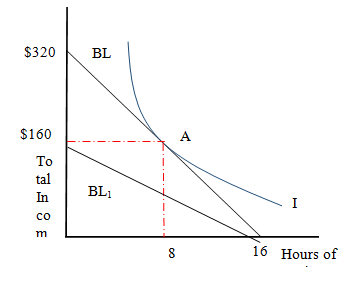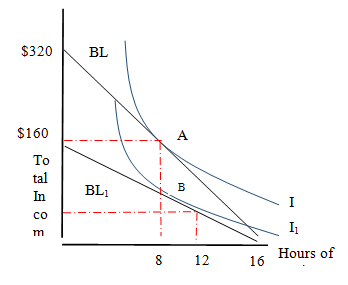
- Leandro’s time allocation budget line and indifference curve at optimal choice.
- Leandro’s new budget line due to change in wage rate.
- Leandro’s indifference curve at optimal choice due to change in wage rate.
- Income and substitution effect.
Concept Introduction:
Indifference curve − An indifference curve is a graph showing combination of two goods that give the consumer equal satisfaction and utility. It represents how much value an individual receives from various combinations of consumption. An individual does not have just one indifference curve. They will have an identically shaped curve at different level of incomes.
Budget line on the other hand is graphical representation of all possible combination of two goods which can be purchased with a given income and prices.
Explanation of Solution
If Leandro spends all of his time working his total income will be 16 x $20 = $320. But if Leandro spends all of his time in leisure he will not have any income. This would give us a time allocation budget line labelled as BL. Now since Leandro decides to consume 8 hours of leisure, he will work for remaining 8 hours a day and have an income of $160. That is Leandro gives up $20 for every hour in which he consumes leisure. The indifference curve in this situation will be tangent to the allocation budget line BL at point A, as given in the diagram below.
As Leandro’s wage rate falls to $10, he might work for 16 hours a day as spending 8 hours on leisure will reduce his total income from $160 (16 x $10) to $80. Considering the substitution effect, Leandro will consume less leisure as the
opportunity cost of leisure will be expensive and substitution effect states that goods which are less expensive will be selected by an individual. In such a situation, the budget line will be represented by a new budget line BL1.If Leandro spends only 4 hours at work due to his reduced wage rate, his total income will be $40. That is, he spends 12 hours a day as leisure time and works for only 4 hours. The indifference curve in such a situation will be tangent to budget line BL1,at point B, as he is working for half the time at the reduced wage rate (i.e at $10 he was working for 8 hours initially and has now reduced his work hours by half the time, 4 hours).
In the above diagram we see that, when Leandro was working for 16 hours a day his total income at the wage rate of $20 was $320. However, he decided to substitute 8 hours of work with leisure and was earning an income of $160. This was due to the income effect. Income effect states that an increase in the wage rate of an individual will lead to an increase in the quantity of goods demanded. That means an increase in Leandro’s income will induce him to spend more time on leisure. When Leandro’s wage rate reduced to $10 per hour, his total income was $40 because of reduced hours of work. This was due to reduced opportunity cost. Leandro had to sacrifice only $10 per hour as compared to $20 for leisure. However, reducing the work hours along with reduced wage rate resulted in Leandro becoming poorer, so he should consume less leisure as it is a normal good. Since the overall consumption has increased from 8 hours to 12 hours, the substitution effect dominates effect.



Want to see more full solutions like this?
Chapter 19A Solutions
MICROECONIMICS
- what is change in TC / change in Q? and what would be an example?arrow_forwardhow to solve the attachment?arrow_forwardProblem 3-ABC Challenges: Attrition, Balance and ComplianceCan television inform people about public affairs? Political scientists Bethany Albertson and Adria Lawrence (2009) conducted an experiment in which they randomly assigned people to treatment and control groups to evaluate the effect of watching TV on a person’s information level. Those assigned to the treatment group were told to watch a specific television broadcast and were later asked questions related to what they watched. Those in the controlgroup were not shown the TV broadcast but were asked questions related to the material in the TV broadcast. The dataset contains the following variables: : Dummy variable which =1 if a person reads news and 0 otherwise. : interest in political affairs (not interested=1 to very interested=4) : years of education : female dummy variable (female=1; male=0) : family income in thousands of dollars : information level (low information level=1 to high information level=4) =1 if the…arrow_forward
- Problem 2-Experiments/Randomized Control Trial Suppose you are interested in studying the effect of academic counselling on the years it takes for a student to obtain an undergraduate degree. You conduct a randomized control trial to answer the question. You randomly assign 2500 individuals in a university in New York to receive academic counselling and 2500 students to not receive any academic counselling. a. Which people are a part of the treatment group and which people are a part of thecontrol group? b. What regression will you run? Define the variables where required. c. Suppose you estimate = -0.3. Interpret it. d. You test for balance using the variables mentioned in the table below. Based on the results do you think that the treatment and control group are balanced? If your answer is “yes” then explain why. If your answer is “no”, then explain why and mention how will you address the issue of imbalance. e. Suppose that some unmotivated students in the control group decided to…arrow_forwardHow to calculate total cost?arrow_forwardProblem 1-Experiments/Randomized Control TrialSuppose you are interested in studying the effect of being a part of the labor union on anindividual’s hourly wage.You collect data on 1000 people and run the following regression. where is a dummy variable which is equal t to 1 for people who are a part of labor union and0 for others. a. Suppose you estimate . Interpret b. Do you think is biased or unbiased? Explain. Now suppose you conduct a randomized control trial to answer the same question. Yourandomly assign some individuals to be a part of the labor union and others to not be a partof the labor union. The first step you take is to ensure that the randomization was donecorrectly. Then you estimate the following equation: =1 if the student is assigned to be a part of Labor Union=0 if the student is assigned to not be a part of Labor Union c. Why is it important to ensure that the randomization is done correctly? d. Name any two variables that you can use to test if Treatment and…arrow_forward
- What is kiosk?arrow_forwardIf food is produced in the U.S., sold in the U.S. and consumed in the U.S., a reduction in its price will have which of the following effects ______? Two of the answers are correct. The consumer price index will decrease. None of the answers are correct. The GDP deflator will decrease.arrow_forwardhow to caculate verible cost?arrow_forward
- What is the deficit?arrow_forwardIdentify the two curves shown on the graph, and explain their upward and downward slopes. Why does curve Aintersect the horizontal axis? What is the significance of quantity d? What does erepresent? How would the optimal quantity of information change if the marginal benefit of information increased—that is, if the marginal benefit curve shifted upward?arrow_forward6. Rent seeking The following graph shows the demand, marginal revenue, and marginal cost curves for a single-price monopolist that produces a drug that helps relieve arthritis pain. Place the grey point (star symbol) in the appropriate location on the graph to indicate the monopoly outcome such that the dashed lines reveal the profit-maximizing price and quantity of a single-price monopolist. Then, use the green rectangle (triangle symbols) to show the profits earned by the monopolist. 18 200 20 16 16 14 PRICE (Dollars per dose) 12 10 10 8 4 2 MC = ATC MR Demand 0 0 5 10 15 20 25 30 35 40 45 50 QUANTITY (Millions of doses per year) Monopoly Outcome Monopoly Profits Suppose that should the patent on this particular drug expire, the market would become perfectly competitive, with new firms immediately entering the market with essentially identical products. Further suppose that in this case the original firm will hire lobbyists and make donations to several key politicians to extend its…arrow_forward

 Principles of Economics (12th Edition)EconomicsISBN:9780134078779Author:Karl E. Case, Ray C. Fair, Sharon E. OsterPublisher:PEARSON
Principles of Economics (12th Edition)EconomicsISBN:9780134078779Author:Karl E. Case, Ray C. Fair, Sharon E. OsterPublisher:PEARSON Engineering Economy (17th Edition)EconomicsISBN:9780134870069Author:William G. Sullivan, Elin M. Wicks, C. Patrick KoellingPublisher:PEARSON
Engineering Economy (17th Edition)EconomicsISBN:9780134870069Author:William G. Sullivan, Elin M. Wicks, C. Patrick KoellingPublisher:PEARSON Principles of Economics (MindTap Course List)EconomicsISBN:9781305585126Author:N. Gregory MankiwPublisher:Cengage Learning
Principles of Economics (MindTap Course List)EconomicsISBN:9781305585126Author:N. Gregory MankiwPublisher:Cengage Learning Managerial Economics: A Problem Solving ApproachEconomicsISBN:9781337106665Author:Luke M. Froeb, Brian T. McCann, Michael R. Ward, Mike ShorPublisher:Cengage Learning
Managerial Economics: A Problem Solving ApproachEconomicsISBN:9781337106665Author:Luke M. Froeb, Brian T. McCann, Michael R. Ward, Mike ShorPublisher:Cengage Learning Managerial Economics & Business Strategy (Mcgraw-...EconomicsISBN:9781259290619Author:Michael Baye, Jeff PrincePublisher:McGraw-Hill Education
Managerial Economics & Business Strategy (Mcgraw-...EconomicsISBN:9781259290619Author:Michael Baye, Jeff PrincePublisher:McGraw-Hill Education





